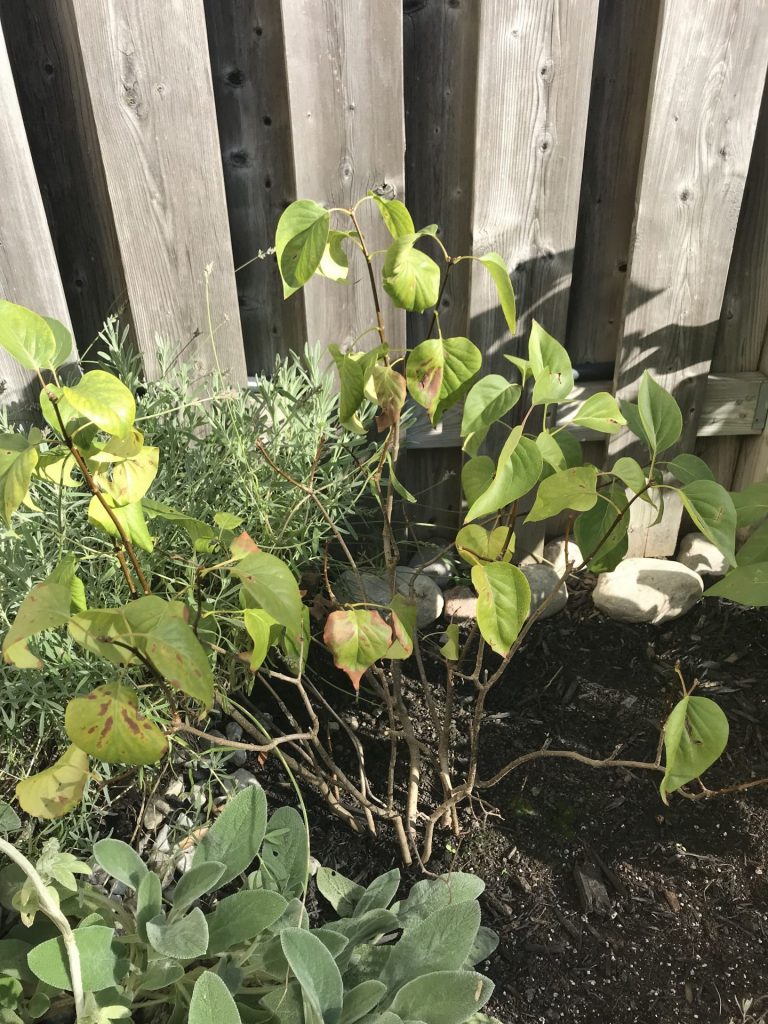
Hi everyone. Does anyone know what is happening to my lilacs? A few weeks ago they started losing leaves like crazy. We planted them in spring and all summer we didn’t see any issues. Now the leaves look droopy and wilted and keep falling. Thanks!
Thank you for contacting the Toronto Master Gardeners concerning your Lilac. There are a number of factors which could be causing the dropping or wilting of your lilac leaves.
First is environment. Lilacs grow best in full sun–at least 6 hours/day and require plenty of air circulation to thrive. They also require moist, well-drained, humus-enriched soil- they hate wet feet. Have you been giving your lilac adequate moisture? You do not mention if you have clay or sandy soil. The addition of a layer of organic material–compost or shredded leaves applied in the spring and/or the fall–would not only help to hold the moisture in your soil if it is sandy but it will also help break up clay soil and will add much needed nutrients to any soil.
Lilacs are vulnerable to two diseases: powdery mildew and bacterial blight. From your photo it does not appear that your lilac is suffering from powdery mildew. Have you observed blackened streaks on one side of the young stems? If this is the case then your plant is suffering from bacterial blight. Bacterial blight is caused by the bacteria Pseudomonas syringae . Bacterial blight first appears as brown patches on the leaves. The brown spots spread and blacken, eventually spreading to the stems which eventually wither and die. The affected shoots will show the Shepard’s crook symptom which is typical of this disease. See this link from Oregon State University for more information on how to recognize and prevent this disease.
Another fungal problem of lilacs is leaf spot. Leaf spots like powdery mildew is a result of high humidity. Poor air circulation around the shrub and wet leaves are the perfect environment for these fungal spores to thrive. Cleaning up the fallen leaves and disposing of them in the garbage not in your compost bin is one way to get a handle on this disease. See Summer Foliar Lilac Diseases for more information.
Lilacs are also susceptible to Verticillium Wilt. The fungus attacks through the roots and spreads upward through the xylem (i.e. water conduits) of the host tree/sbrub. The infection blocks the xylem, causing wilting and premature leaf drop. Symptoms typically first show up as sudden wilting and death of one or several branches, or even one side of the tree. See Verticillium Wilt of Tree and Shrubs
Lastly, have you observed any insects on the underside of your leaves? It could be that the brown spots are caused by the leaf miner insect, Caloptilia syringella. This insect begins as a small 0.25” caterpillar that mines the tissue between the upper and lower leaf surfaces (epidermis) causing browning of the leaves. Later the caterpillar emerges and spins a web around the curled leaves and further skeletonizes the leaves. See Lilac Leafminer for more information on this pest.
From you photo it appears that your lilac is planted relatively close to surrounding plants. Depending on the variety of lilac, these shrubs can get quite large, upwards of 5’ which will eventually crowd out the plants nearby. Since your lilac was just planted this spring I would advise transplanting it sooner than later. Spring or fall are the best times to transplant trees and shrubs. Do not prune prior to transplanting. Choose a new spot with good sunlight; at least 6 hours per day. Ensure the location has good drainage. Dig a wide hole around the base of the shrub, getting as much of the root system as possible and keep as much soil on the roots as possible. Dig a hole in the new location that is two times wider and the same depth as the root ball. Do not add topsoil or compost or other soil amendments to the planting hole as this will limit root growth to the prepared “pocket”. Fan the roots out and refill with the original soil. Press down gently and firmly. Water thoroughly and deeply about every day for the first two weeks and continue to water every two to three days for the next couple of weeks to encourage the roots to re-establish.
The key to successfully treating the problem is being able to identify the cause. Hope the above information narrows down your search.

